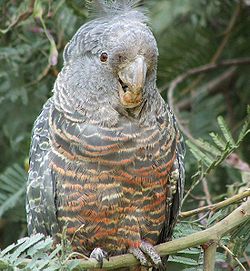| Gang-gang cockatoo | |
|---|---|
 | |
| Adult male | |
 | |
| Female | |
| Scientific classification | |
| Kingdom: | Animalia |
| Phylum: | Chordata |
| Class: | Aves |
| Order: | Psittaciformes |
| Family: | Cacatuidae |
| Genus: | Callocephalon Lesson, RP, 1837 |
| Species: | C. fimbriatum |
| Binomial name | |
| Callocephalon fimbriatum (Grant, J, 1803) | |
 | |
| Range of C. fimbriatum | |
The gang-gang cockatoo (Callocephalon fimbriatum) is a parrot found in the cooler and wetter forests and woodlands of Australia, particularly alpine bushland. It is the only species placed in the genus Callocephalon. Mostly mild grey in colour with some lighter scalloping (more pronounced and buffy in females), the male has a red head and crest, while the female has a small fluffy grey crest. It ranges throughout south-eastern Australia. The gang-gang cockatoo is the faunal emblem of the Australian Capital Territory. It is easily identified by its distinctive call, which is described as resembling a creaky gate, or the sound of a cork being pulled from a wine bottle.
Contents
- Taxonomy
- Description
- Distribution and habitat
- Behaviour and ecology
- Breeding habits
- Diet
- Status
- Gallery
- References
- External links
The name gang-gang comes from a New South Wales Aboriginal language, probably from one of the coastal languages, although possibly from Wiradjuri. It is probably an onomatopoeic name. [2]




